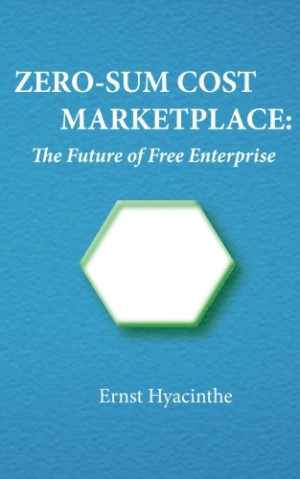ZERO-SUM COST MARKETPLACE
The Future of Free Enterprise
This creative book details an interesting method for building a balanced marketplace.
Ernst Hyacinthe’s premise—that a buyer can actually pay “zero” for a product or service—is intriguing to say the least. In Zero-Sum Cost Marketplace, Hyacinthe makes the case that consumers can be “equity partners” with sellers, and that the seller can place a portion of the gross sale in a trust investment account. By investing one percent of the price of a product, the author writes, “these contributions increase in value to cover the original transaction cost.”
As with any scheme that sounds too good to be true, there are strings attached. The biggest issue is not the concept, which in itself is creative and ingenious, but rather the execution, which requires a whole new way of thinking about the basic buyer-seller relationship. One example cited is real estate transactions, in which brokers receive commissions and mortgage lenders receive fees: “If the buyer were to bank one percent also, the real estate investment would become diversified. … Homeowners, as part of the supply chain, would shun subprime mortgage markets as destructive.” Yet, how likely is it that brokers or mortgage lenders would relinquish one percent of every real estate transaction? And wouldn’t the consumer continue to find subprime rates more attractive than a potential one-percent rebate—especially if not every lender agreed to factor in the rebate?
To his credit, Hyacinthe does point out that many industries already offer purchase incentives to customers via loyalty and frequent buyer programs, suggesting this factor creates a “precedent” for a one-percent cost rebate. Loyalty and frequent buyer programs, however, were established with a different objective: to reward customers for buying repeatedly from the same source. If every seller offered a one percent rebate, loyalty programs would probably not exist.
Chapters are short; at times they fail to adequately describe how a zero-cost marketplace might actually work. The chapter referencing industries that might make use of this idea is only two-and-a-half pages long, with only a single paragraph for each of four industries. The discussion of logistics and supply chain management presented as a basis for the concept is also not fully and clearly explained. In referring to “consumer driven logistics,” for example, Hyacinthe writes, “This means that before a product can be designed, a project must be designed. Risk reduction becomes the added value goal of this project.”
In terms of page design, the book would have benefited from subheads, highlighted copy, and perhaps tables or charts to further illustrate the zero-sum concept rather than blocks of plain text. The cover graphic of a nondescript shape does little to enhance the subject matter or make the book stand out.
While the book references several economists, it does not indicate how their theories support the idea of a zero-sum cost marketplace. There is no information in the book about the author’s background, experience, or credentials, which further undermines the credibility of the thesis.
The book concludes that, “In five years, one trillion dollars re-enters the investment markets as consumer participation,” and further projects that, “in fifty years the consumer investment asset conservatively grows to 15 trillion dollars.” There is very little in this book to substantiate such claims.
Zero-Sum Cost Marketplace’s premise comes across as a largely unfounded idea, yet also an interesting one.
Reviewed by
Barry Silverstein
Disclosure: This article is not an endorsement, but a review. The publisher of this book provided free copies of the book and paid a small fee to have their book reviewed by a professional reviewer. Foreword Reviews and Clarion Reviews make no guarantee that the publisher will receive a positive review. Foreword Magazine, Inc. is disclosing this in accordance with the Federal Trade Commission’s 16 CFR, Part 255.


